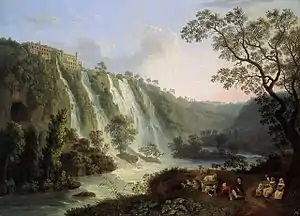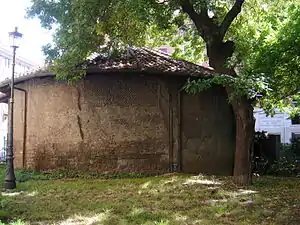Gardens of Maecenas
The Gardens of Maecenas, built by Gaius Maecenas, an Augustan-era patron of the arts, were the first gardens in the Hellenistic-Persian garden style in Rome. He sited them on the Esquiline Hill, atop the agger of the Servian Wall and its adjoining necropolis, near the gardens of Lamia.


Site
Topographers disagree about whether the gardens lay on both sides of the Servian Wall and both north and south of the porta Esquilina. Many of the burial pits of the ancient necropolis, attested to predate the gardens, have been found near the north-west corner of the Piazza Vittorio Emanuele, that is, outside the porta Esquilina and the Servian Wall and north of the via Tiburtina vetus. Probably, the horti extended north from that gate and road, on both sides of the agger.[1]
Facilities
The Latin all-encompassing term for gardens, horti, is an effective misnomer, as in antiquity it referred generally to luxury villas on the outskirts of Rome, so-named for especially prominent vegetation and urban removal.[2] The rustic yet holistic complex seems to have featured libraries, pavilions, riding grounds, baths, and an aviary. Each part of the gardens was visually and physically accessible by successive terraces and porticos.[3]
The Aqua Marcia, an essential aqueduct for the city, delivered high-quality water directly past Maecenas's property on the Esquiline, making the grounds uniquely poised to be maintained as one of the first private, landmark Roman gardens.[4] This was crucial to another purported logistical feat of the gardens; Maecenas is said to be the first Roman to build a hot water swimming pool.[5]
A significant statuary collection has been excavated in the garden's vicinity, raising the probability of an outdoor art gallery. Several marble fountains, pointedly mirroring the unparalleled gardens around them, blur the line between the tamed cultivation and human imitation of nature. These animal likenesses include the horn-shaped rhyton now displayed in the Capitoline Museums.[6]
Maecenas's sponsored retinue of influential Latin poets recorded some direct observations of his Esquiline gardens. Propertius mentions that Maecenas “preferred a shady oak and falling waters and a few reliable acres of fruitful soil."[7] In his ode to Maecenas, his close associate Horace emphasizes the sweeping elevation of the garden estate over the expanse of Rome, ultimately symbolic of his friend's detached yet esteemed semi-retirement, spent closely advising Augustus.[8]
The so-called Auditorium of Maecenas

The Late Republican-era room preserved on the grounds of the horti, termed the "auditorium of Maecenas" in modernity, was likely a triclinium, functioning as a private banqueting hall attached to residential quarters.[9] The long, rectangular hall terminated with seven monumentalized, marble-clad steps in a semicircular apse. Drill-holes, accommodative of pipes, could indicate this to be the cascade fixture of a fountain. The inside of the room was doubly secluded, with an ancient ramp leading visitors to a subterranean level.[10] In all cases pertaining to sustained gathering and entertainment, this evidence fractures identification hypotheses between an elite ekklesiasterion-like recitation hall, a votively-equipped nymphaeum, or a sumptuously decorated triclinium. The latter two purposes were not mutually exclusive, but often seasonally convertible.[11] Couches would have been placed in the middle of the room, perhaps facing a performance on the transept end.[12]
Evidence as to the social and chronological context of the building includes an erotic epigram by the Greek poet Callimachus, painted onto the interior wall, which entreats a male lover to forgive misbehavior caused by lust and wine.[13] A visually prominent Hellenistic precedent reinforced the individualistic emotionalism and witty experimentation valued by Augustan neoteric and elegiac writers,[14] who would have frequented the weighty functions of Maecenas, a renowned cultivator of culture.[15] In fact, a Latin adaptation of the same poem appears in the works of Propertius, who certainly spent significant time on the estate.[16]

The structure was built directly into the Servian Wall, as the city had long outgrown the defensive fortifications. Verse of Horace attests to the domestic architectural takeover of the Servian Wall in Esquiline garden estates, as when he writes of a "stroll on the sunny rampart."[17]
The interior wall sports seventeen niches, five along the apse and six on either side, decorated with naturalistic frescos depicting landscapes and gardens.[18] However, their correlation to the Pompeian Third Style of Roman painting makes this decoration a likely product of later renovations done by Tiberius.[19] Painting motifs evocative of the Dionysian Mysteries, such as drunken processional scenes with thyrsi and maenads prominent, match the early imperial fascination with cult initiation rites.[20]

The wall enclosing the southeastern side is a post-excavation addition. In its ancient form, the room seems to have been theatrically opened to the city below. Panoramic exposure to both the Alban Hills and the surrounding neighborhoods ensured that occupants could view all while themselves being seen.[21]
History
Prior to its transformation by Maecenas, this area of the Esquiline was a graveyard for the poor.[22] It was cleared of this purpose in 38 BC, when the Roman Senate banned open-air corpse cremation within a two-mile radius of the city.[23] The original phase of the garden was constructed by the conclusion of the 30s BC.[24] The use of opus reticulatum brickwork is the basis for this dating. [25]
Augustus preferred to stay in the gardens of his friend whenever he became ill.[26] When Maecenas died in 8 BC, he left the gardens to Augustus in his will, and they became imperial property thereafter. Tiberius lived there after his return to Rome in 2 AD.[27] Nero connected them with the Palatine Hill via his Domus Transitoria,[28] and was alleged to view the burning of that palatial house from the turris Maecenatiana[29] This turris might be the molem propinquam nubibus arduis ("the pile, among the clouds") mentioned by Horace.[30]
Towards the end of the Julio-Claudian dynasty, Seneca the Younger contended with the legacy of Maecenas through the lens of decadence-despising Stoic philosophy. He said the gardens' immersive blend of art, nature, and water allowed that Maecenas "diverted his worried mind with the sound of rippling waters."[31] This negative reception of the gardens as a weak hermit's retreat is rooted in an indictment of the overarching effeminacy, illiberalism, and intoxication of the class and time which they symbolized. Sensory manipulation and distraction, on the scale of the garden or Maecenas' patronage within, spelled a loss of control incompatible with proper patriarchal goals.[32]
The imperial tutor and consul Marcus Cornelius Fronto purchased the gardens by the mid-2nd century AD. In addition to his surviving correspondence with Marcus Aurelius, which boasts of a special connection to Horace forged by owning the land of Maecenas,[33] nine lead water-pipes inscribed with his name were found adjacent to the so-called auditorium.[34] A domus Frontoniana, mentioned during the twelfth century in the topographical guide to Rome by Magister Gregorius, also may refer to these gardens.[35]
The auditorium and the associated finds of the garden were unearthed and excavated throughout the 1870s, during the feverish post-unification development of Rome into an urban capital city. Consequently, some adjoining remains were minimally described and quickly destroyed. [36]
References
- HJ 345‑7; BC 1874, 166‑171; Richter, 313; LR 411‑413; Cons. 155 ff. for works of art found here.
- Häuber, Chrystina. "The Horti of Maecenas on the Esquiline Hill in Rome" (PDF). Retrieved 21 December 2019.
- Kontokosta, Anne (January 2019). "Building the Thermae Agrippae: Private Life, Public Space, and the Politics of Bathing in Early Imperial Rome". American Journal of Archaeology. 123 (1): 45–77.
- Kontokosta, Anne (January 2019). "Building the Thermae Agrippae: Private Life, Public Space, and the Politics of Bathing in Early Imperial Rome". American Journal of Archaeology. 123 (1): 45–77.
- Cassius Dio LV.7.6
- Wyler, Stéphanie (2013). "An Augustan Trend towards Dionysos: Around the 'Auditorium of Maecenas'". In Bernabe, Alberto; Herrero deJáuregui, Miguel; San Cristóbal, Ana; Martín Hernández, Raquel (eds.). Redefining Dionysos.
- Propertius, Sextus. Elegiae in Maecenatem. p. 1.33-36.
- Hornsby, Roger (December 1958). "Horace, "Ode" 3. 29". The Classical Journal. 54 (3): 129–36.
- University of Virginia, Rectors and Visitors. ""Auditorium" of the Gardens of Maecenas". Rome Reborn. Institute for Advanced Technology in the Humanities. Retrieved 21 December 2019.
- Claridge, Amanda (2010). Rome: An Oxford Archaeological Guide (2nd ed.). Oxford University Press. p. 330.
- Wyler, Stéphanie (2013). "An Augustan Trend towards Dionysos: Around the 'Auditorium of Maecenas'". In Bernabe, Alberto; Herrero deJáuregui, Miguel; San Cristóbal, Ana; Martín Hernández, Raquel (eds.). Redefining Dionysos.
- Claridge, Amanda (2010). Rome: An Oxford Archaeological Guide (2nd ed.). Oxford University Press. p. 330.
- Acosta-Hughes, Benjamin (2019). Henriksen, Christer (ed.). A Companion to Ancient Epigram. John Wiley & Sons. p. 329.
- Arkins, Brian (1988). "The Freedom of Influence: Callimachus and Latin Poetry". Latomus: 285-293.
- Häuber, Chrystina. "The Horti of Maecenas on the Esquiline Hill in Rome" (PDF). Retrieved 21 December 2019.
- Wyler, Stéphanie (2013). "An Augustan Trend towards Dionysos: Around the 'Auditorium of Maecenas'". In Bernabe, Alberto; Herrero deJáuregui, Miguel; San Cristóbal, Ana; Martín Hernández, Raquel (eds.). Redefining Dionysos.
- Flaccus, Horatius. Satires. p. 1.8.13–6.
- University of Virginia, Rectors and Visitors. ""Auditorium" of the Gardens of Maecenas". Rome Reborn. Institute for Advanced Technology in the Humanities. Retrieved 21 December 2019.
- Häuber, Chrystina. "The Horti of Maecenas on the Esquiline Hill in Rome" (PDF). Retrieved 21 December 2019.
- Wyler, Stéphanie (2013). "An Augustan Trend towards Dionysos: Around the 'Auditorium of Maecenas'". In Bernabe, Alberto; Herrero deJáuregui, Miguel; San Cristóbal, Ana; Martín Hernández, Raquel (eds.). Redefining Dionysos.
- Claridge, Amanda (2010). Rome: An Oxford Archaeological Guide (2nd ed.). Oxford University Press. p. 333.
- Horace, Satires, I.8
- Cassius Dio 48.43.3
- Claridge, Amanda (2010). Rome: An Oxford Archaeological Guide (2nd ed.). Oxford University Press. p. 330.
- Kontokosta, Anne (January 2019). "Building the Thermae Agrippae: Private Life, Public Space, and the Politics of Bathing in Early Imperial Rome". American Journal of Archaeology. 123 (1): 45–77.
- Suetonius, Divus Augustus 72.2
- Suetonius, Tiberius 15
- Tac. Ann. XV.39
- Suet. Nero 38
- Horace, Odes, iii.29.10.
- Sen., Prov. 1.3.10
- Graver, Margaret (Winter 1998). "The Manhandling of Maecenas: Senecan Abstractions of Masculinity". The American Journal of Philology. 119 (4): 607–632.
- Fronto, ad M. Caesarem 2.2 - "Plane multum mihi facetiarum contulit istic Horatius Flaccus, memorabilis poeta mihique propter Maecenatem ac Maecenatianos hortos meos non alienus. Is namque Horatius Sermonum libr(o) s(ecundo) fabulam istam Polemonis inseruit, si recte memini, hisce versibus..."
- Häuber, Chrystina. "The Horti of Maecenas on the Esquiline Hill in Rome" (PDF). Retrieved 21 December 2019.
- Journal of Roman Studies, 53.1 (1919:35)
- Wiseman, T.P. (20 September 2016). "Maecenas and the Stage". Papers of the British School at Rome. 84: 131–155.
Sources
- Horace, Satires i.8.14 - "nunc licet Esquiliis habitare salubribus atque / aggere in aprico spatiari, quo modo tristes / albis informem spectabant ossibus agrum,/cum mihi non tantum furesque feraeque suetae/hunc vexare locum curae sunt atque labori/quantum carminibus quae versant atque venenis/humanos animos: has nullo perdere possum/nec prohibere modo, simul ac vaga luna decorum/protulit os, quin ossa legant herbasque nocentis."
- Acro, Porphyrio, and Comm. Cruq. ad loc.
- Topographical Dictionary